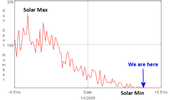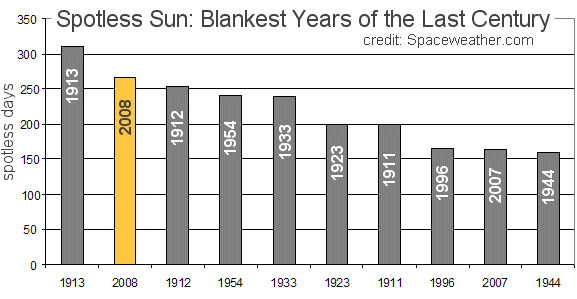No we aren't talking pianos, but Grand Solar Minimums. Today a new milestone was reached. As you can see below, we've been leading up to it for a few years.
A typical solar minimum lasts 485 days, based on an average of the last 10 solar minima. As of today we are at 638 spotless days in the current minimum. Also as of today, May 27th, 2009, there were no sunspots on 120 of this year's (2009) 147 days to date (82%).
Paul Stanko writes:
Our spotless day count just reached 638.Of course it depends on what data you look at. Solar Influences Data Center and NOAA differ by a few days. As WUWT readers may recall, last year in August, the SIDC reversed an initial count that would have led to the first spotless month since 1913:
What is so special about 638? We just overtook the original solar cycle, #1, so now the only cycles above this are: cycles of the Maunder minimum, cycles 5 to 7 (Dalton minimum), and cycles 10 + 12 to 15 (unnamed minimum).
Since the last one is unnamed, I've nicknamed it the "Baby Grand Minimum", in much the same way that you can have a baby grand piano. We would now seem to have reached the same stature for this minimum. It will be interesting to see just how much longer deep minimum goes on.
Sunspeck counts after all, debate rages...Sun DOES NOT have first spotless calendar month since June 1913
NOAA did not count the sunspot, so at the end of the month, one agency said "spotless month" and the other did not.
From Spaceweather.com in an April 1st 2009 article:
The mother of all spotless runs was of course the Maunder Minimum. This was a period from October 15, 1661 to August 2, 1671.We do indeed live in interesting times.
It totaled 3579 consecutive spotless days. That puts our current run at 17.5% of that of the Maunder Minimum.
By the standard of spotless days, the ongoing solar minimum is the deepest in a century: NASA report. In 2008, no sunspots were observed on 266 of the year's 366 days (73%). To find a year with more blank suns, you have to go all the way back to 1913, which had 311 spotless days (85%):
The lack of sunspots in 2008, made it a century-level year in terms of solar quiet. Remarkably, sunspot counts for 2009 have dropped even lower.





Reader Comments
to our Newsletter